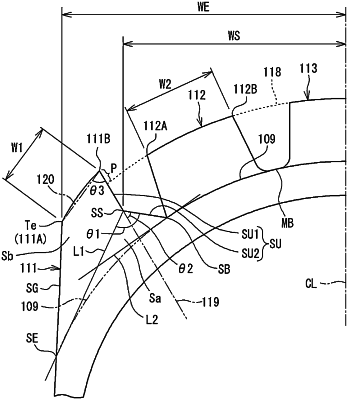| CPC B60C 11/11 (2013.01) [B60C 11/1323 (2013.01); B60C 11/1376 (2013.01); B60C 2200/10 (2013.01); B60C 2200/14 (2013.01)] | 8 Claims |

|
1. A tire for a motorcycle for running on rough terrain, the tire comprising a tread portion, wherein
the tread portion includes a plurality of blocks raised from a groove bottom surface,
the plurality of blocks include a plurality of shoulder blocks forming tread ends, and a plurality of middle blocks adjacent to inner sides in a tire axial direction of the shoulder blocks,
in a meridian cross-section including a tire rotation axis in a normal state which is a state where the tire is fitted on a normal rim with a normal internal pressure and no load is applied to the tire, an inner edge in the tire axial direction of a land surface of each shoulder block protrudes on an outer side in a tire radial direction with respect to a virtual profile obtained by extending a profile of a land surface of the middle block to the shoulder block,
an inner side surface on the inner side in the tire axial direction of each shoulder block includes one first inner side surface extending from the axially inner edge toward a groove bottom between the shoulder block and the middle block, and a second inner side surface extending from a bottom side end of the first inner side surface toward the groove bottom,
the shoulder block second inner side surface is a surface inclined toward the inner side in the tire axial direction relative to the first inner side surface,
the shoulder block first and second inner side surfaces each include a flat surface,
a middle block outer side surface on the outer side in the tire axial direction of each middle block includes a flat surface and extends from an outer edge in the tire axial direction of a land surface of each middle block toward the groove bottom,
a bottom side end of the middle block outer side surface of each middle block is adjacent to the groove bottom,
in the meridian cross-section, contours of the flat surfaces of the shoulder block first and second inner side surfaces, as well as the middle block outer side surface, are all represented by a straight line,
the bottom side end of the shoulder block first inner side surface is located axially outward of a normal line of the land surface of each shoulder block at the axially inner edge,
a bottom side end of the shoulder block second inner side surface is adjacent to the groove bottom, and
the middle block outer side surface and the shoulder block second inner side surface form a tapered shape with the groove bottom being an apex,
an angle formed by the shoulder block second inner side surface and a first virtual surface obtained by extending the shoulder block first inner side surface toward an inner side in the tire radial direction is greater than 30° and not greater than 80°,
an angle formed by the shoulder block first inner side surface and a second virtual surface connecting an outer edge and the inner edge in the tire axial direction of the land surface of the shoulder block is not less than 55° and not greater than 80°,
a line segment connecting the bottom side end of the shoulder block first inner side surface and a bottom side end of a shoulder block outer side surface on the outer side in the tire axial direction of the shoulder block is a first reference line, and a line segment connecting the groove bottom between the shoulder block and the middle block and the first reference line and tangent to the groove bottom surface at the groove bottom is a second reference line,
an area of a region surrounded by the land surface of the shoulder block, the shoulder block first inner side surface, the first reference line, and the shoulder block outer side surface is defined as a main body area, and an area of a region surrounded by the shoulder block second inner side surface, the second reference line, and the first reference line is defined as a mountain portion area,
a ratio of the mountain portion area to the main body area is not less than 5% and not greater than 7%,
an angle formed by the first reference line and the shoulder block second inner side surface is not less than 80° and not greater than 100°, and
a ratio of a distance in the axial direction from a tire equator plane to the bottom side end of the shoulder block first inner side surface to a distance in the axial direction from the tire equator plane to the tread end is not less than 70% and not greater than 85%.
|